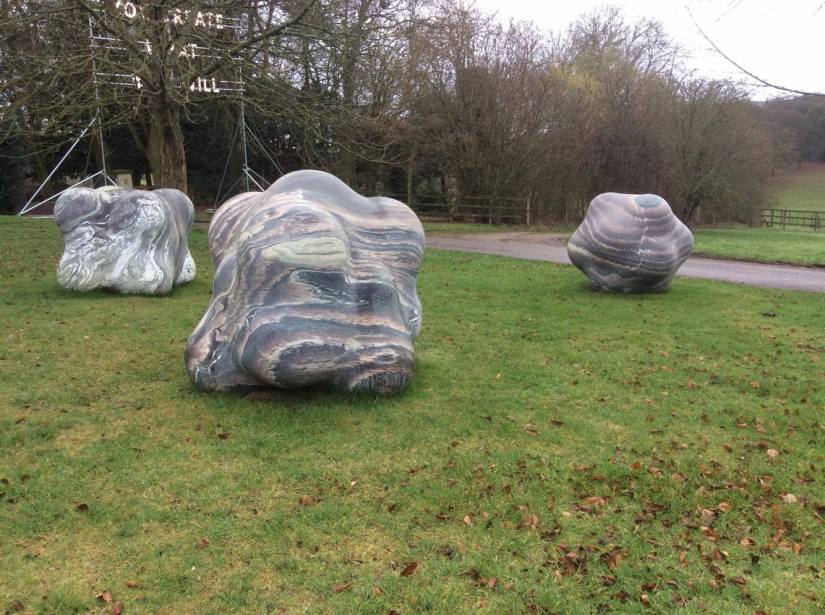Peter Randall-Page is a British sculpture artist born in 1954. He studied at Bath Academy of Art from 1973-1977. Randall-Page has gained an international reputation over the last 25 years through his sculpture, drawings and prints. His famous work has been displayed all over the world Japan, South Korea, Australia, USA, Turkey, Germany and the Netherlands.
Peter’s work has always has always beeninspired by the study of natural phenomena and its subjective impact on our emotions. He often looks at patterns within nature as well, this can be seen in the sculpture exhibited below through the natural patterns within the Marbe. Furthermore, he was highly interested in geometry and stated on his website…
“geometry is the theme on which nature plays her infinite variations, and can be seen as a kind of pattern book on which the most complex and sophisticated structures are based.”
Although it is not obvious, each of the Marble pieces in the photo below can be cut symmetrically. The sculpture was made through the carving of Marble. This sculpture is called…
“Shapes in the clouds”


This sculpture is displayed along the driveway of Roche Court. Its form and material is extremely striking upon arrival as it is immensely large yet holds such intricate, fine detail within it. The piece appeals to most people as it always looks incredible no matter what the weather. In sunshine, the contrast of both shadows and light beam off of its matte form. Conversely, in rain the material looks polished and the colours within the stone are enhanced, giving it a vibrant feel.
Potential lesson ideas:
Idea 1:
Children could create their own animal symmetry. Using paint, paint one half of an animal of their choice e.g. butterfly, fold the paper and see the reflected symmetry art on the other side of the paper. This links to Peter Randall-Page’s work as he looks at symmetry within his sculptures.
This idea would be perfect for KS1 as it is hands on concrete learning with across-curricular links to mathematics with the line of symmetry element. The idea also allows children to practically implement ideas derived from the focused artist.
Primary National Curriculum – Art and Design Key Stage 1 Subject Content links…
“to use drawing, painting and sculpture to develop and share their ideas, experiences and imagination”
“to develop a wide range of art and design techniques in using colour, pattern, texture, line, shape, form and space”
“about the work of a range of artists…”
Primary National Curriculum – Art and Design
Primary National Curriculum – Mathematics Key Stage 1, Year 2 Subject Content links…
“identify and describe the properties of 2-D shapes, including the number of sides and line symmetry in a vertical line”
Primary National Curriculum – Mathematics
This aim within the National Curriculum suggests that children should know what a symmetry line is and be able to identify it within shapes. This art activity is an engaging way to start this process of learning and thinking.
Idea 2:
Continuing with the line of symmetry lesson focus derived from Randall-Pages symmetrical sculptures, children could draw a self portrait. Stick one half a photograph (of the individual) onto a piece of paper. Provide children with mirrors so they can accurately draw their own features onto the other side of the paper, allowing the photograph to look reflected. Children will also establish learning of where the line of symmetry is on their face (vertical or horizontal) and understand that their facial features are symmetrical. Moreover, this activity also provides an opportunity for self expression and the development of your own personal drawing style. As the symmetry understanding and artistic techniques used are more advanced, this activity would be more appropriate for KS2 children.
Primary National Curriculum – Art and Design Key Stage 2 Subject Content links…
“to improve their mastery of art and design techniques, including drawing, painting and sculpture with a range of materials [for example, pencil, charcoal, paint, clay]”
“about great artists, architects and designers in history.”
Primary National Curriculum Art and Design
Primary National Curriculum – Mathematics Key Stage 2, Year 4 Subject Content links…
“complete a simple symmetric figure with respect to a specific line of symmetry.”
Primary National Curriculum Mathematics
